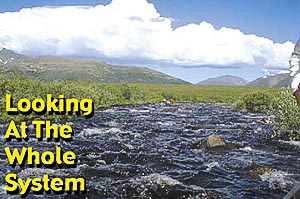

According to Medlar, the problems water treatment facilities must overcome are numerous: waterborne diseases, crumbling infrastructures and system issues are just some of the obstacles. For example, Medlar tells us that a report from The Water Infrastructure Network "estimates that in order to maintain our systems, not improve them, is going to require an investment of something like $23 billion a year."
Another issue facilities must deal with is the tightening government regulations regarding water quality. Medlar explains that the U.S. Environmental Protection Agency (EPA) will implement even stricter laws in 2003. He says at that time, "all of the regulations that apply to surface water will also apply to ground water. Furthermore, all regulations also will apply to all public water systems, regardless of their size." (Under current laws, small systems are exempt from certain regulations.)
In an attempt to tackle these problems, Medlar says treatment processes have changed drastically over the past two decades. "Back in the '80s," he describes, "the first plant I worked on was easy - you had taste, you had odor, you had color, you threw the chlorine in, and you tried to make the water aesthetically pleasing and biologically safe. Disinfectant byproducts were unheard of and a lot of other issues didn't exist."
Today's treatment methods are more complex, and designers must "look at the specifics of what we're trying to remove," Medlar says. "We have what we call synergistic antagonism where we can have different substances that work against each other - sometimes they work against each other in our treatment systems, and sometimes they work against each other in the human body and that is very, very difficult to modify."
Of course, when choosing a treatment process, water professionals must take into account whether they are dealing with surface water or ground water - there are some differences between the two sources and treatment should be problem specific, Medlar explains. Typical surface water quality problems include turbidity and suspended particles; microbes and protozoan; rapid water quality variations; temperature changes; organics and disinfection byproducts; and unknown discharges. On the other hand, typical ground water problems include iron and manganese; volatile/synthetic organics; corrosiveness; organic color; radionuclides; and arsenic.
Although Medlar seems to express a preference for ground water (specifically that from alluvial aquifers), he admits that there are pros and cons in treating both types. "I think one of the advantages of the alluvial type of withdrawl systems is that the water quality tends to be more consistent [than surface water]. That makes a world of difference in terms of operating plants and the cost of plants. Second, the temperature tends to be much more consistent. On the other hand, I think we're looking at significant challenges with arsenic and radionuclides [with ground water]."
Whether dealing with surface water or ground water, Medlar identifies three main categories of water treatment processes: chemical addition, destruction/detoxification and separation. He notes that destruction/detoxification is where many in the industry feel they'd like to go in the future since these processes have no environmental impact, as opposed to separation processes which must deal with the issue of residuals management after harmful substances are removed from the water.
What are some of the processes being used to treat specific water problems? Medlar referenced many, but ultimately stressed that when creating a treatment system, designers must make sure they're tackling all problems, not just treating one or two. "You have to look at the whole matrix," he stresses. "In some cases, we're overemphasizing the technologies, asking them to do a bit more than they're really capable of doing."
Report Abusive Comment